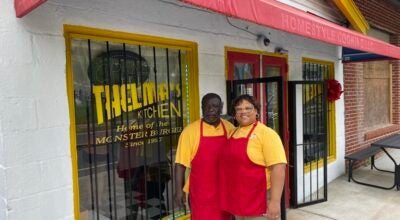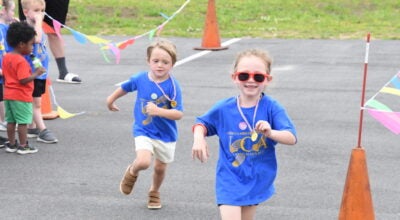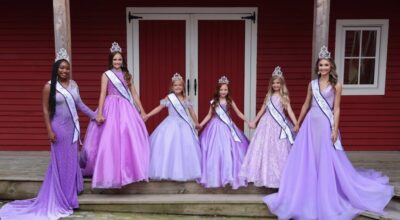Chilton bore brunt of ’32 twisters
Published 7:03 am Saturday, February 25, 2012
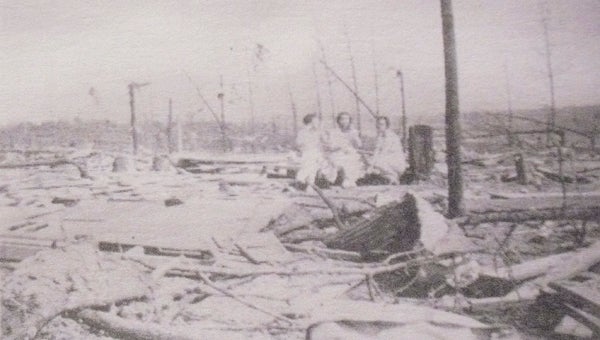
This photo shows three women sitting among the devestation in Union Grove, one of the hardest hit areas in the 1932 tornado. Almost every home there was destroyed.
Sometimes in the evenings when the wind howls just right, Lucille McFarland can’t help but think back 80 years to that terrible night. Still today, a sudden storm from the southwest sends her thoughts swirling back to the day the twisters struck.
McFarland and her family survived the tornadoes that devastated Chilton County on March 21, 1932, but many weren’t so lucky. A massive storm system hit the Deep South that day — most of the damage came in Alabama, and Chilton County suffered perhaps more than anyone.
Newspaper records from the time show that more than 300 died in what is still Alabama’s deadliest tornado outbreak. Across Chilton County at least 58 perished in the storms that injured hundreds, left even more homeless and wiped entire communities off the map.
It’s no surprise the day would stay with survivors like McFarland — those still around to share their storm stories today were just children then, grade-school students who witnessed things they will never forget.
‘DON’T YOU REALIZE HALF OF CHILTON COUNTY HAS JUST BEEN BLOWN AWAY?’
The day started without any signs of the horrible things on the horizon.
March 21 fell on a Monday that year. It was the week of Easter, and churches across the county were preparing for special pageants and programs. The temperatures hovered a few degrees above average. That afternoon, thermometers got close to 75 under a sunny, cloudless sky.
Weather forecasts in Monday’s edition of The Montgomery Advertiser called for a cool down in coming days and mentioned a chance of thunderstorms but nothing to the extent of what was about to happen.
But it’s likely that accurate forecasts would have made little to no difference in the hardest hit areas. In 1932, many families in rural Alabama didn’t have radios, and a daily newspaper was something you could only get during trips to town. Most of the storm’s victims had no idea what was coming until it was on top of them.
Another survivor of the storm, Anne Crowe Glass, lived with her parents, brother and sister in a house halfway between Jemison and Union Grove. Though only 5 years old then, she remembers how car after car seemed to be racing down her normally quiet country road that night.
Her father finally told her mother that he was going to go flag someone down to see what was happening. The first vehicle to pass by was an ambulance, one of many coming from Birmingham and Montgomery to help.
When her dad asked the ambulance driver where all the cars were going, he got back a surprised look and then a chilling response…
“The ambulance driver says, ‘My God, man, don’t you realize half of Chilton County has just been blown away?’”
It’s a question the Glass family and so many other residents would soon discover the incomprehensible answer to.
According to the March 24 edition of the Union-Banner (what is today The Clanton Advertiser), two tornadoes raked their way across the county that evening.
The first twister came in from the southwest corner of the county near Plantersville. The storm then plowed through the communities of Stanton, Pleasant Grove and Liberty Hill.
In describing the damage, a writer for the Union-Banner said, “every home of any kind in the narrow path was torn into kindling wood and scattered everywhere.”
The twister then continued on its path, hitting Lomax around 5:30 p.m. before doing more destruction in Cane Creek and along Lay Dam Highway.
Lives were snuffed out and property destroyed in each of those communities, but the storms were only beginning.
The second tornado followed about an hour behind the first one — Act II in a tragedy playing out across Chilton County. This twister entered the county around Randolph and tore through Pates Chapel, Macedonia and the northern part of Thorsby. Almost everything between Collins Chapel and Union Grove, two of the more densely populated areas in the county, was gone, carried away with the wind.
The tornado finally left Chilton County after crossing Smith Schoolhouse and Waxahatchee Creek and setting its sights on Columbiana.
With the sun now gone over the western sky and power transformers splintered like toothpicks, a permeating darkness descended. Heavy rains continued well into the night, but they weren’t enough to drown out the horrifying sounds, the moans of the injured and screams from the desperate.
THE GREATEST CALAMITY IN CHILTON COUNTY HISTORY
In their first edition after the tornadoes, the Union-Banner writers tried to summarize what had just happened.
“Half a hundred dead — more than two hundred injured, more than a hundred homes destroyed — widespread destruction and devastation of property. This begins the story of the greatest calamity that has ever befallen the people of Chilton County…”
The simple words begin an account that attempts to relay the terror the tornadoes caused. A long list of the dead and injured runs prominently down two columns of the newspaper.
The authors acknowledge in some instances though that “words are not capable of describing the havoc that was wrought … homes and businesses of all kinds in the path of the storm were not only blown down; they were scattered everywhere and torn to bits.”
McFarland and her family lived in Thorsby at the time, not too far from where Thorsby High School and Helen Jenkins Chapel are today. She was just 10 years old, but she said she would never forget the sounds from that night.
“My family was not nervous people. They didn’t get upset about the weather, but I remember (that night), and it still affects the way I feel when the wind blows. I remember the wind — the thunder and lightning was not what got me — it was the wind.”
The wind, which broke a rose trestle away from her family’s front porch, otherwise spared her home.
“I distinctly remember hearing that frame tearing loose from the house,” McFarland said. “And, of course, I remember the morning after and all the devastation.”
While McFarland’s family home was mostly undamaged, a hitching post and water trough still used for carriages a block away was destroyed.
The Union-Banner also recapped the critical hours after the storms passed when rescue workers were first responding: “People were found scattered all over the countryside. Children were found alone in the wreckage, dead, injured and suffering, separated and lost from their families. Roads were obstructed by every kind of debris, and the injured in many instances had to be carried in arms for two miles to be placed in automobiles. All of this horrible picture was enacted in a torrential rain that lasted for hours after the storm.”
Yet rescue crews kept responding from across the county and Birmingham, Montgomery and Selma. They worked throughout the night using lanterns to search the wreckage as well as fields and nearby woods for the dead and injured. The only other light rescuers had was from homes that had caught fire and were burning.
The Clanton hospital soon reached capacity, and every doctor office in Chilton County was turned into a temporary one. Patients were also rushed to other regional hospitals.
McFarland remembers a particularly gruesome injury concerning a Littleton boy.
“(A few days after the tornadoes) he had a swelling in his throat; they thought he had the mumps, but it was a wood splinter that had gone behind his ear and had become infected … Imagine the wood blowing hard enough to do that,” McFarland said.
The next day nearly every business was closed as everyone came out to help, including the American Legion, members of various ladies clubs, school kids and merchants.
The Alabama National Guard went to work to provide tents, cots and blankets to people who lost their homes, and the American Red Cross started offering aid too. A grocery store in Thorsby was converted into a temporary treatment center, McFarland said.
ANOTHER TORNADO
As Chilton County finally started to come to terms with what happened on Monday, a third tornado hit the county six days later on Easter. The storm closely followed the path of the second twister.
In fact, many people who had come from Birmingham to Montgomery to sightsee and gawk at the damage done earlier in the week found themselves having to take sudden shelter in road ditches as the storm blew over.
Undoubtedly still on edge from the Monday storms, the sight of more severe weather proved too much for some residents.
The Union-Banner recounts a story of Lurline Latham, a Lawley girl, who saw the tornado coming toward her and was “seized by a cramp and became unconscious at the appalling sight.” Dr. Dubouse of Maplesville later determined she had ruptured her appendix upon seeing the storm, the paper reported.
This storm proved weaker than the first two, but at least six people still died in it and more homes were destroyed. Tents set up for survivors were blown away too.
Both McFarland and Glass witnessed the Easter storm pass by from their front yards. Glass and her family took shelter in her grandmother’s flower pit, where potted plants were kept during winter.
GOD-FEARING AND HARD-WORKING LOT
The days that followed were some of the saddest Chilton County has ever known as funeral after funeral took place. Storm victims ranged from infants just a few days old to 80-year-olds.
Entire families were killed. Jack Latham of Plantersville died as well as his wife and five children. Berney Chandler survived but lost his wife and two children.
Few families didn’t know someone killed in the storms. Easter services at Pleasant Grove were cancelled because one of the actors in the program died and two more were injured, according to a report in the Chilton County News.
Glass can remember attending her first funeral ever in the days following the storm. A 20-year-old cousin of hers, Hollie Mims, died while running to take refuge in a ditch as the twister approached. Both his mother and father survived.
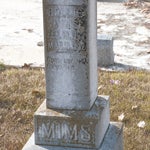
This tombstone marks the grave of 20-year-old Hollie Mims, a cousin of Anne Crowe Glass who died in the tornado.
“When they realized a storm was coming, they left their house, and they were going out to the road to get what shelter they could in a ditch. Just as they were in the middle of the road, the storm struck them,” Glass said. “It knocked them all down and just rolled them. It killed Hollie. They never knew what hit him. They were three people together, and the youngest one was killed.”
A few days later, Glass attended the funeral of her cousin, the Chandlers and two members of another family.
“As I remember, there were six coffins of tornado victims,” Glass said.
Chandler and his brother were free masons and built the house Glass lives in today. One day when building the house, Chandler told Glass what happened to him that night.
“He had bought his children a rubber ball the day before, and they were playing with it in the house,” Glass said. “He told me the house suddenly seemed to explode, and his wife and two children were killed.”
Chandler would later go on to remarry and have another family, Glass said.
The days that followed were hard for tornado victims, but the same resilience and determination they used to live off the land helped them get through the tough times.
The Chilton County News poignantly summed up the outlook of survivors when describing the people of Collins Chapel and Union Grove: “(They) are a God-fearing and hard working lot. Until now, they have known little suffering on account of the Depression. … Even now the visitors hear no appeal for help. Here is one group of people who are accustomed to helping themselves and caring for each other in times of need. They do not know how to ask for help. And so they go along their way unsmiling, rummaging through the wreckage of their homes, attending their sick and wounded and burying their dead, asking nothing and grateful to an all-wise Providence that it wasn’t any worse.”
‘IT JUST HAS THAT SOUND’
Storm pits were built across Chilton County in the months and years following the storms, McFarland and Glass both attest to.
“After that, storm pits sprung up like mushrooms all over Chilton County,” Glass said. “People weren’t bashful about getting in storm pits.”
Though McFarland’s family never built an underground shelter, the storm always had an effect on her family. She said her grandmother would come and wake her up during particularly bad storms and insist she get dressed.
She would tell her, “If we get blown away, it would be better to have your clothing (on).”
Glass said while she isn’t frightened by tornadoes, she still can’t pass by the property where her cousin was killed without being taken back to the night 80 years ago.
“I don’t pass that way often, but when I do I have vivid memories of that house,” Glass said.
McFarland said the wind still gets to her, if only every now and then.
“When the wind blows from a certain direction, it still gives me a little weary feeling,” McFarland said. “Certain things just stay with you. I have sat here in my kitchen many, many nights, and when the wind blows from the southwest — and I don’t know why it is — but it sounds almost like a woman crying. And I have sat here in this kitchen and think I was about to be blown away. It just has that sound.”
This story is part of PROGRESS 2012, which is on news stands Saturday, Feb. 25 through Monday, Feb. 27.




